Nuggets of News Blog
|  |
Monday, April 06 2015
It is with great sadness that we share the news that Dr. Charles L. Garrett died on April 3, 2015. We are grateful for the contributions Dr. Garrett made to our industry, and for the fine example he always put forth for others. The Garrett name will always be synonymous with high-quality metal detectors, including those used in security applications, law enforcement, military, sports, and outdoor recreational use. Although he will be dearly missed by many, his legacy will endure.

Charles L. Garrett —inventor, entrepreneur, treasure hunter, patriot, husband, and father—died on April 3, 2015. A native Texan and resident of Garland, Dr. Garrett and his wife Eleanor in 1964 founded Garrett Electronics which grew to become the world’s largest manufacturer of metal detection equipment.
Garrett detectors have discovered some of the world’s most valuable buried treasures, and its security equipment has protected millions of travelers and others, including Olympic athletes and spectators at the Games since 1984. Dr. Garrett was born in Houston on April 1, 1932, and grew up in Lufkin. After four years of service in the U.S. Navy during the Korean conflict on board the USS Bottineau (APA-235), he graduated from Lamar University in Beaumont with a degree in electrical engineering. A lifelong treasure-hunting hobbyist, Dr. Garrett first developed a metal detector for his own use and because it was so much superior to others, he and his wife founded a company to sell it.
He pioneered the development of the modern metal detector, demonstrated its capabilities searching for treasure throughout the world and devoted himself to teaching others to use detectors. He discovered treasure with metal detectors of his own design on every continent except Antarctica, and he also scanned under lakes, seas and oceans of the world. Many of the treasures and relics he discovered are displayed in the Garrett Museum at the company’s factory in Garland. In 1984 the company also began to manufacture walk-through and hand-held security detectors, including the famed Super Scanner®, the world’s most popular hand-held detector, and revolutionary new walk-through units. As a patriotic American, Dr. Garrett generously donated his company’s equipment for numerous projects where metal detection equipment was required, including many of the Olympic Games.
He authored some 20 books and wrote literally scores of articles about metal detectors, treasure hunting on both land and under water and security. Many of his books remain in print. Today, the name Garrett stands as a worldwide synonym for treasure hunting and security metal detectors. Charles himself has been called the Grand Master Hunter. Along the way, he also became recognized as an unofficial spokesman for the hobby of treasure hunting and the metal detecting industry through a long list of honors, personal appearances, books and articles. U.S. Representative Sam Johnson visited the Garrett factory in February 2010 to read and present to Dr. Garrett a copy of the Congressional Record in which he acknowledged the quality and determination of Garrett’s American-made products. Charles and Eleanor Garrett have been generous contributors to Lamar University and her alma mater, Sam Houston State University. Both have been granted honorary doctor’s degrees from these schools. Charles Garrett was presented with an honorary Doctor of Humane Letters degree during Lamar’s spring commencement ceremonies in May 2011. The Charles and Eleanor Garrett Engineering Center was dedicated at Lamar University in April 2012.
Dr. Garrett was an Eagle Scout and an inductee into Eta Kappa Nu, the national Electrical and Computer Engineering honor society. In 2004, Governor Rick Perry commissioned Charles Garrett as an honorary Admiral in the Texas Navy. He was also a member of the Sons of the Republic of Texas and was a Distinguished Alumni of both Lufkin High School and Lamar University.
Survivors include his wife of almost 60 years, Eleanor; three children, Charles Lewis Garrett, Jr., Deirdre Lynne Garrett Hasselbach and her husband Timothy of Albuquerque, New Mexico, and Vaughan Lamar Garrett, his wife, Angela, and their two children, David and Sydney. Dr. Garrett was a member of the Saturn Road Church of Christ. Dr. Garrett was preceded in death by his parents, Wayne L. and Stella Barber Garrett; and his brothers, George Wayne Garrett and Donald Bert Garrett.
Visitation will be at Sparkman Crane Funeral Home in Dallas, Texas, on Friday, April 10, from 7:00 to 9:00 pm. A memorial service will be held at Orchard Hills Baptist Church in Garland, Texas, at 2:00 pm on Saturday, April 11, 2015. Graveside services will be conducted at 3:00 pm on Sunday, April 12, at Calvary Cemetery in Trinity County, Texas, east of Crockett on FM 357. In lieu of flowers, anyone desiring to make a donation can do so in memory of Charles Garrett to: Lamar University Foundation, P.O. Box 11500, Beaumont, Texas, 77710.
Thursday, March 26 2015
Gold rush towns boomed all over the American West in the 1800s, but did you know that some prospectors were striking it rich up in Canada during the same time? The Cariboo Gold Rush of 1861 triggered the settlement and success of Barkerville in British Columbia. In its heydey, it was the largest city west of Chicago and north of San Francisco. At the time it was thought that Vancouver and Victoria would never amount to much because they were too far away from Barkerville! Today, more than 100 historic structures are still standing on the spots that they were built; many are active businesses. For the price of admission, this period frontier town offers daily activities and special events during the summer— guided town tours, blacksmithing demonstrations, story-telling by costumed interpreters, living history presentations— as well as shopping, dining, gold panning, and much more. were too far away from Barkerville! Today, more than 100 historic structures are still standing on the spots that they were built; many are active businesses. For the price of admission, this period frontier town offers daily activities and special events during the summer— guided town tours, blacksmithing demonstrations, story-telling by costumed interpreters, living history presentations— as well as shopping, dining, gold panning, and much more.
Barkerville is named after Billy Barker from Cambridgeshire, England, who was among the first lucky miners to find gold here in Williams Creek, and whose claim was the richest and the most famous. Billy began his gold-seeking career as a California ‘49er, then headed north with his fellow miners after the California Gold Rush played out. In 1868, a fire spread quickly through Barkerville’s wooden shanties, completely destroying the town. Reconstruction began immediately, and within six weeks, 90 buildings had been rebuilt, boardwalks were improved, and the narrow and winding main street was widened and straightened. In no time, businesses of every description were once again open to meet the needs of miners.
Strolling the dirt streets of Barkerville this summer is a fun way to glimpse what mining life would have been like here in the late 19th century. Mining relics are everywhere. Many of the historic buildings are filled with displays, not only about mining, but also depicting family life, firearms, and early businesses. Barkerville’s exotic Chinatown is the largest collection of pre-railway Chinese buildings in North America and boasts one of the largest Chinese archival collections in Canada. Although more than 150 years have passed since gold was first discovered here, with all the activity and visitors in town, you’d almost think that the Gold Rush was still in full swing at this Provincial Heritage Site of Canada. You'll find Barkerville Historic Town located 50 miles east of Quesnel, BC at the end of Highway 26.
Monday, February 16 2015
Depending on where you live, spring is in the air either a little or a lot, or maybe not at al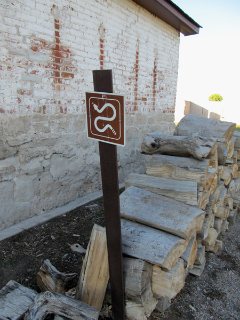 l yet. If you're in a southern or western state, you're probably getting out and about more— in the woods or the desert— to prospect, metal detect, and just clean up the backyard and flower beds (don't forget your Woodman's Pal machete for clearing brush and pruning). As you venture outside more often, or travel to sunnier climates, keep in mind that it is not too early in the season to have to worry about snake bite protection. A warmer than expected winter in some places has caused snakes to come out of hibernation earlier than usual. Just recently, a 14-year-old boy was airlifted out of Mission Trails Regional Park in San Diego, California after a rattlesnake bit his leg. In Arizona, an adult was badly bitten on the knuckle of his middle finger. In warmer southern states, snakes often don't go into hibernation at all. Instead, they go into "brumation." l yet. If you're in a southern or western state, you're probably getting out and about more— in the woods or the desert— to prospect, metal detect, and just clean up the backyard and flower beds (don't forget your Woodman's Pal machete for clearing brush and pruning). As you venture outside more often, or travel to sunnier climates, keep in mind that it is not too early in the season to have to worry about snake bite protection. A warmer than expected winter in some places has caused snakes to come out of hibernation earlier than usual. Just recently, a 14-year-old boy was airlifted out of Mission Trails Regional Park in San Diego, California after a rattlesnake bit his leg. In Arizona, an adult was badly bitten on the knuckle of his middle finger. In warmer southern states, snakes often don't go into hibernation at all. Instead, they go into "brumation."
Hibernation is a deep sleep, usually occuring in colder, snow covered climates in northern states. Snakes don't actually sleep in brumation, but their bodies acclimate to a lower temperature, their metabolism slows, and they become less active and less inclined to feed. Brumation or hibernation is necessary for breeding. If male snakes don't cool down at some point during the year, they most likely would not be able to produce fertile sperm.
 On warm days, brumating snakes sometimes come out of their dens to bask in the sunshine. Nice sunny winter days are often when people are On warm days, brumating snakes sometimes come out of their dens to bask in the sunshine. Nice sunny winter days are often when people are  surprised by snakes. Just like us, snakes head out to enjoy the sun and unsuspecting humans can startle them and cause them to strike. Rattlesnakes usually try to get way from people and bite only when attacked -- or when they perceive they are being threatened or attacked. Many bites occur when snakes are accidentally stepped on. Wear snake gaiters or snake boots and you'll know you're protected in case that happens. Gaiters are also great protection against thorns, pricker bushes, and cacti needles. If you've ever brushed against cacti while on a hike, you know how painful they can be and how hard to remove those needles are! surprised by snakes. Just like us, snakes head out to enjoy the sun and unsuspecting humans can startle them and cause them to strike. Rattlesnakes usually try to get way from people and bite only when attacked -- or when they perceive they are being threatened or attacked. Many bites occur when snakes are accidentally stepped on. Wear snake gaiters or snake boots and you'll know you're protected in case that happens. Gaiters are also great protection against thorns, pricker bushes, and cacti needles. If you've ever brushed against cacti while on a hike, you know how painful they can be and how hard to remove those needles are!
Generally, rattlesnakes emerge from true hibernation in March or April, or when the average daytime temperatures reach and remain about 60 degrees Fahrenheit and higher. In the spring, keep in mind that emerging snakes are hungry, thirsty, and ready for love! With spring approaching, follow the Boy Scout motto and be prepared. Just like the US Border Patrol, US Forestry Service, hunters, hikers, fishermen, ranchers, surveyors, realtors, landscapers, and thousands of treasure hunters, wear snake gaiters or snake boots and you'll know you're protected when in the desert or woods. Don't take a chance!
Wednesday, January 21 2015
 If you've not yet attended a GPAA (Gold Prospectors Association of America) Gold & Treasure Show, the coming months provide an opportunity to rub elbows with some of the best prospectors and manufacturers in the business! Browse the show floor to find the latest and greatest gold mining and metal detecting equipment, see product demos, attend free seminars, ask questions of the pros, and enter to win door prizes. Weekend shows run 10 am - 4 pm. Presale admission is $5 by registering online or $10 at the door. If you've not yet attended a GPAA (Gold Prospectors Association of America) Gold & Treasure Show, the coming months provide an opportunity to rub elbows with some of the best prospectors and manufacturers in the business! Browse the show floor to find the latest and greatest gold mining and metal detecting equipment, see product demos, attend free seminars, ask questions of the pros, and enter to win door prizes. Weekend shows run 10 am - 4 pm. Presale admission is $5 by registering online or $10 at the door.
Mark your calendars for these dates and cities:
- February 7-8 Pomona Fairplex in Pomona CA
- February 28-March 1 Mesa Convention Center in Mesa, AZ
- March 7-8 San Joaquin Fair in Stockton, CA
- March 28-29 Portland Expo Center in Portland, OR
- April 11-12 Western Idaho Fair in Boise, ID
- April 25-26 South Point Casino in Las Vegas, NV
- May 16-17 National Western Complex in Denver, CO
- May 30-31 Metrolina Tradeshow Expo in Charlotte, NC
- June 6-7 Knoxville Convention Center in Knoxville, TN
Visit the GPAA website for more details and online registration. See you there!
Monday, January 19 2015
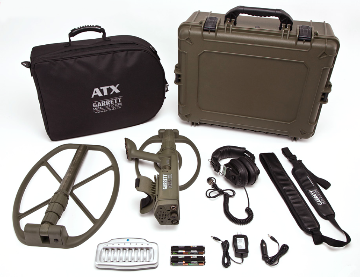 Garrett's new pulse induction ATX metal detector is the ultimate multi-frequency detector for all terrains and extreme conditions (highly mineralized ground, saltwater, etc.). It features advanced pulse induction technology, a durable design that meets military specifications, and an advanced 20 inch Deepseeker searchcoil is ideal for use in searching for caches and other deeply buried large objects. The ATX is waterproof to 10 feet. Garrett's new pulse induction ATX metal detector is the ultimate multi-frequency detector for all terrains and extreme conditions (highly mineralized ground, saltwater, etc.). It features advanced pulse induction technology, a durable design that meets military specifications, and an advanced 20 inch Deepseeker searchcoil is ideal for use in searching for caches and other deeply buried large objects. The ATX is waterproof to 10 feet.
PI (pulse induction) detectors work a bit differently than the more common VLF (very low frequency) detectors by putting magnetic field energy into the ground and then switching off and waiting a short period before they start to look for a response. This makes them better at handling ground mineralization than a VLF detector because during that short delay the magnetic response of iron trash minerals that you don't want to find dies out. VLF detectors do not as easily cancel out ground mineralization the way a PI metal detector can do.
Kevin Hoagland, Executive Director of Development for the Gold Prospectors Association of America recently field tested the Garrett ATX Deepseeker. Below is an excerpt of Kevin's review:
"My first impression of the ATX was that it's compact, heavy and built like a tank, and all connections are waterproof. Battery installation is simple. The ATX uses 8 AA batteries in two 4-battery drop-in packs and comes with an 8-slot AA battery charger. Not only does this detector come with a rugged case and carry bag, but also everything else you need to get out detecting. The units ships with the 20 inch mono coil already installed. It is also shipped with headphones that are screwed into the back of the unit.
I slipped my arm into the adjustable cuff, and grabbed the control pod. There was no unnecessary torque on  my wrist, which gave it a perfect fit and feel, and allowed me to work all of the control buttons easily with my thumb. I pushed the unit out in front of me a bit and turned on the power switch, which is located on the back of the unit. The Garrett ATX Deepseeker Metal Detector goes through its startup and self-diagnostic test. Every light on the control pad comes on and unit emits several different sounds before settling into a comfortable, but high, threshold. This is not a turn-on-and-go detector. Either read the entire owners manual before you go out hunting, or at least read the first two pages of the manual— page 1 is the Quick Start Guide and an explanation of how to access the functions of the ATX quickly, and page 2 shows you where to find more information concerning those functions. my wrist, which gave it a perfect fit and feel, and allowed me to work all of the control buttons easily with my thumb. I pushed the unit out in front of me a bit and turned on the power switch, which is located on the back of the unit. The Garrett ATX Deepseeker Metal Detector goes through its startup and self-diagnostic test. Every light on the control pad comes on and unit emits several different sounds before settling into a comfortable, but high, threshold. This is not a turn-on-and-go detector. Either read the entire owners manual before you go out hunting, or at least read the first two pages of the manual— page 1 is the Quick Start Guide and an explanation of how to access the functions of the ATX quickly, and page 2 shows you where to find more information concerning those functions.
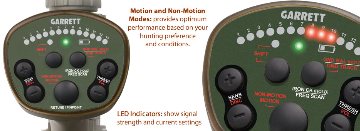 There are 5 major functions that are completely user-adjustable: Mode, Sensitivity, Threshold, Volume, and Ground Balance. Are functions are easy to adjust with a basic understanding of the ATX and more tunable as you become more proficient. Secondary functions include iron check, tracking, discrimmination and frequency shifting, to name only a few. There are 5 major functions that are completely user-adjustable: Mode, Sensitivity, Threshold, Volume, and Ground Balance. Are functions are easy to adjust with a basic understanding of the ATX and more tunable as you become more proficient. Secondary functions include iron check, tracking, discrimmination and frequency shifting, to name only a few.
As with most large PI detectors, the Garrett ATX Deepseeker Metal Detector is not light, and the waterproofing adds extra weight. Were it not for the ergonomic design, detectorists not accustomed to the weight of these machines might tire quickly. The supplied sling is easy to use, adjust, and offers a fair way to alleviate some of the weight, but I found it uncomfortable for long periods of use. Many avid detectorists use after-market harness systems, so you may want to check out those options if you plan to spend long days detecting.
In the field, the Deepseeker performed exceptionally well. The unit demonstrated almost complete immunity to all but the worst hot rocks I encountered. The ground balance and multi-speed ground tracking worked great, but I found that I rarely used the ground tracking as the ATX handled most of the soil mineralization in the OFF position. The threshold was quick to respond to ground changes and a simple ground balance was all that was needed to bring the ATX back into maximum depth and sensitivity. The Iron Check works well, maybe even too well! I dig everything no matter what and I have had a very successful nugget-hunting career doing just that. I have found good targets under junk on many occasions. Be careful and mindful that gold, like junk, is where you find it and there is no law of detecting that states there will be no gold under junk!
Regardless of your level of detecting expertise, it will take some time to get comfortable with all the functions and navigating the menus of the ATX. With multi-button presses to access some functions, it's important to take time to learn the machine well beyond the quick-start level. Overall, Garrett has created a PI detector that is extremely well made with solid functionality. The ATX offers great value for your dollar. Garrett has again carved a niche in the metal detector market, and the ATX perfectly has met the needs expressed by detectorists worldwide..."
You can find Kevin's complete field test review on pages 16-19 of the November/December 2014 issue of Gold Prospectors Magazine, or download the .pdf here. You can also get more information and watch a video of the Garrett ATX Deepseeker Metal Detector on this website.
Sunday, January 11 2015
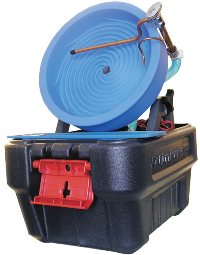 If you're looking for a proven fine gold recovery tool that has been on the market for decades, consider the Desert Fox Spiral Gold Panning Machine. It's easy to use, and recently Kevin Hoagland, Executive Director of Development for the Gold Prospectors Association of America (GPAA) conducted a field test review which was published on pages 14-17 of the January/February 2015 issue of Gold Prospectors Magazine. Here's an excerpt of Kevin's findings and you can also click on the image at the end of this post to download a complete copy of the field test review (4-page .pdf). If you're looking for a proven fine gold recovery tool that has been on the market for decades, consider the Desert Fox Spiral Gold Panning Machine. It's easy to use, and recently Kevin Hoagland, Executive Director of Development for the Gold Prospectors Association of America (GPAA) conducted a field test review which was published on pages 14-17 of the January/February 2015 issue of Gold Prospectors Magazine. Here's an excerpt of Kevin's findings and you can also click on the image at the end of this post to download a complete copy of the field test review (4-page .pdf).
"... The Desert Fox ships in an Action Packer case that is the storage, transport, and water container unit. It provides excellent protection for the Fox while giving you a true compact recirculating unit that can be transported easily. Unpacking the container was simple and for those of us that spend little time looking at the way something comes out of a container, the manufacturer has included a photo in the manual to show you how to repack the unit so it's back to being travel-ready in just a few seconds. In the container you will find:
- A-frame with variable speed drive motor connected as one unit
- 7 lead 12.5 inch double wall spiral recovery wheel
- Adjustable water spray bar
- Tailings catch tray
- 12-volt 750 GPH pump and flow hose from pump to spray bar
- Instructions
- Recovery cup
- Nylon stocking for the pump
- Small bag of practice sand with flecks of real gold.
Setup takes just a few moments. The wheel frame is a single point A-frame that sits perfectly in place in the container and allows you a stable, easy-to-set-up base for the spiral unit. The A-frame construction also allows the unit to be set up directly in a stream. Stand the A-frame in the container, lift the drive unit to a beginning angle, slide the double-wall wheel into the slot on the drive motor, attach the spray bar, fill with water, hook up to a 12-volt power supply (not included), and after a couple of fine tuning adjustments, the Desert Fox is ready to start running your concentrates. Total time from cased to running is about two minutes!
The A-frame mounted drive motor allows you to easily make small adjustments to the angle of the wheel. This ease-of-use factor can become critical when running materials that require more precision. Water flow is controlled by a single-point knob on the spray bar assembly, and the speed control is located on the back of the unit. These 3 adjustments are all you need to ensure efficient gold recovery. Before first use, be sure to clean with a good quality dish washing soap to remove all the manufacturing oils (mold-release agents from the plastic parts). Do NOT use a citrus-scented soap because the scent is derived from oils, which is exactly what you are trying to remove. Use hot soapy water and a non-abrasive pad.
Spiral panners work in reverse of traditional hand panning. Instead of gravity separating gold from concentrates with the heavies sinking to the bottom of a pan, a spiral machine uses speed, water, and the angle of the spiral wheel to keep lighter material in the bottom of the wheel, while the heavier black sand and gold is brought up the leads. When set correctly, the sands drop off at the last moment and only gold is moved through the center of the unit and recovered in the cup.
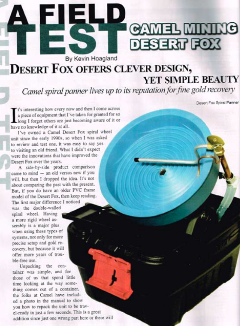 I recommend classifying your dirt to a minimum of .25 inch to 1/8 inch mesh. Once classified and prepared to run, feed the material slowly into the bottom of the wheel. I've found it best to use a tablespoon. Increase the feed rate after all necessary adjustments are made. I recommend classifying your dirt to a minimum of .25 inch to 1/8 inch mesh. Once classified and prepared to run, feed the material slowly into the bottom of the wheel. I've found it best to use a tablespoon. Increase the feed rate after all necessary adjustments are made.
Starting with the water first, find the lowest water pressure that will clean the light material from the leads as it climbs up the pan, adjust the angle and speed as needed so the heavy sands drop off at the right spot and you're ready to start processing your concentrates. After completing the basic setup, I adjusted the speed to keep the unit tuned in to variations in the types of material I ran. There are two models of the Desert Fox— a constant speed ($339) and a variable speed ($359). Since the difference in price is just $20, I highly recommend the variable speed model.
The Desert Fox is a straight-forward and simple spiral wheel system that recovers gold efficiently, and has been manufactured by Camel Mining since 1969. It is compact, weighs about 10 pounds, and is ideal for carrying into the field. Gold recovery is exceptional and the learning curve is short..."
Click here to learn more about the Desert Fox Spiral Panner on this website. Click image to download .pdf of field test review.
Friday, January 02 2015
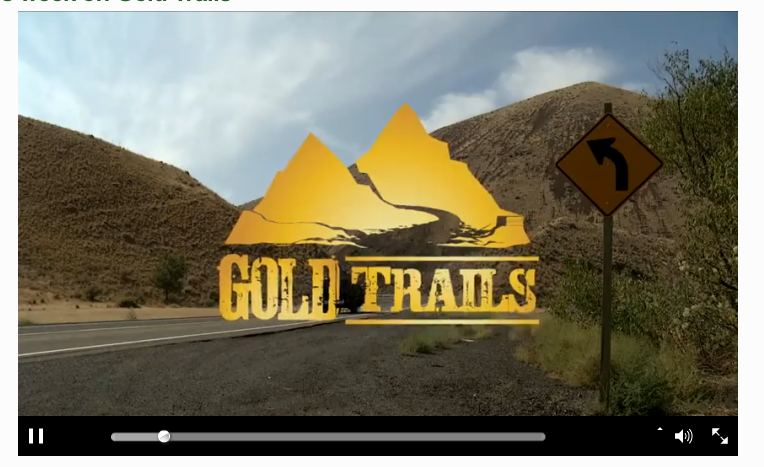 Gold Trails is a new TV show produced by the Gold Prospectors Association of America (GPAA) that promotes the lifestyle of the prospector. Host Kevin Hoagland travels the country working with local prospectors and equipment manufacturers in search of the next big gold strike. Gold Trails is really an introduction for the general public to basic prospecting — to a lot of people who haven’t experienced it yet. Gold Trails is a new TV show produced by the Gold Prospectors Association of America (GPAA) that promotes the lifestyle of the prospector. Host Kevin Hoagland travels the country working with local prospectors and equipment manufacturers in search of the next big gold strike. Gold Trails is really an introduction for the general public to basic prospecting — to a lot of people who haven’t experienced it yet.
The premiere episode of Gold Trails will air Saturday, January 3, 2015 on the following local TV stations:
- KDOC TV — Los Angeles, 8 a.m (LA 56 — Verizon Fios HD is 506)
- AZTV — Phoenix, Ariz. — 11 a.m.
- KWVT — Salem, Ore., 10:30 a.m. (available to viewers in Portland)
The following excerpt and information is found on the GPAA's website.
Gold Trails has been three years in the making, but is worth every minute of the wait, said GPAA President and Executive Producer Brandon Johnson. He’s confident viewers will feel the same by the time they’ve watched all seven weekly half-hour episodes of this first season. Though Johnson, who is Tom Massie’s stepson, is carrying on the family business, he has stepped outside of the Massie family for the first time with the choice of Hoagland as the on-camera personality and the public persona of the GPAA. But, Hoagland is first and foremost a gold prospector with solid roots in the small-scale mining industry as well as the GPAA and Lost Dutchman's Mining Association, so he’s a natural fit.
Although Johnson is a gold prospector and miner, he admits he never grew up immersed neck-deep in mining the same way as Tom and Perry Massie did. Still, he has spent countless hours at mining camps with Tom, his mother, Cindy and his siblings and he’s grown to love the mining community and GPAA family. “My grandfather was a miner. What drives me is not necessarily the mining as much as that mining community my grandfather created,” he said.“It was always important to me. To me it’s a great pleasure.”
It takes a certain kind of person to be on-camera and, Johnson by his very nature ducks and dodges the limelight, preferring instead a behind-the-scenes management approach. “I wouldn’t be opposed to it, if it makes sense for the episode,” he said, quipping, “I can give a tour of the office.” Humbly, he said, that the miners who are out in the field, rolling up their sleeves and getting down to the nitty-gritty can better reflect what gold prospecting is all about to viewers than he can as a company president, which carries with it the burden of financial and managerial responsibilities. “They have so much more to say than I do ... but I have no problem jumping in there,” he said.
Johnson is convinced Hoagland is the right person for the job of Gold Trails host. “This is a show that we’ve been passionate about producing for a few years, but the chemistry really needed to be right. My grandfather was a baseball player, and so he built a baseball field. We’ve had the opportunity with the baseball field for a long time, but we’ve been looking for the right players and the right coach. Now, I think we’ve got that,” Johnson said. “To me, it’s important. I can probably play baseball, but I’m not a baseball player; Kevin is. So, with his ability and how similar our passion is — as far as his passion to get the information out there and to help people and the joy he gets from it — I’ve got a baseball player. I can continue to be the athletic director, while Kevin is taking on the responsibility from a television, media standpoint ... and I’m a big supporter of it.”
While Gold Trails started out much like Gold Fever episodes (another GPAA TV series), the formula was changed to make it more educational with a little less of the antics that are Tom Massie’s trademark.
Although Hoagland had been visible in the mining industry, Johnson was especially impressed with him at a GPAA Gold & Treasure Show, where Hoagland had led a popular seminar on metal detecting. It was apparent then — and still is — that Hoagland’s passion for prospecting floweth over the proverbial cup. And, he has the knowledge and experience to back it up.
Listening to the story of how Hoagland got his first metal detector and then set out to create a better one, and then explore metals and geology, Johnson was impressed with Hoagland’s inquisitive nature, gumption and gusto. “I think that says a lot about how Kevin’s mind works ... He wanted to understand how the Earth works. He is very knowledgeable,” Johnson said. “We had a similar focus. I’ve met hundreds of people over the years at gold shows, but Kevin really stood out — his voice and his presence and his knowledge of prospecting.”
Rather than having six minutes of commercial time for big national advertiser on Outdoor Channel, Johnson hopes Gold Trails will expand from three to 20 different local markets, which means plenty of advertising spots for local mining equipment and prospecting shops. “Gold Trails to me is about starting that gold rush everyone expected to happen. I think a lot of people have a fascination with gold when the price fluctuates. People get excited about prospecting for gold, but I don’t think many of them know how to get started, ” Johnson said. “We’re giving people the next step. The prospecting and mining industry, really doesn’t have a show like this.”
And, no other gold prospecting TV series can offer viewers a chance to join a national membership-based organization and go out prospect on mining claims across the United States. The GPAA also has publications, such as Gold Prospectors magazine, the Pick & Shovel Gazette, and a network of local chapters that Gold Trails viewers can join for free to become part of the small-scale mining community and learn more about the industry.
Mining rights
When it comes to mining rights, Johnson said the GPAA has consistently been a strong voice for keeping public lands open to prospecting, mining and other outdoor uses, such as hunting, fishing, hiking and biking, for example. “For the last few generations, mining in this country has become something you read about in history, but that doesn’t mean in today’s word that it has gone away,” Johnson said. “It’s still done in other countries very efficiently and it’s a huge part of their economies. And, the way I see it, there will come a time when it will be part of our economy again. It has to. Grandpa said, ‘If you can’t grow it and you can’t mine it, it doesn’t exist.’ ”
And, Massie couldn’t have been more right — computers, smart phones, vehicles and the fuel that goes in them, plastics, electrical wires — virtually everything including the kitchen sink comes from some type of mining.
Historically, during periods of high unemployment or a depressed economies, many Americans looked to prospecting and mining on public lands to earn to living. “We don’t want to lose that access to public lands. I think people need to experience it. It’s great to be able to go out there casually without the need to support your family ... When you go out there and experience it, I think a lot of people get a sense of how important it actually is. You can’t care about public lands unless you’ve had a mining claim and you have that right that right is being taken away from you,” he said. “You are much more passionate about it when you’ve got a vested interest. So, this show is really about getting back to basics and encouraging people to understand prospecting and to feel more connected to public lands and to their rights and what they may be losing if they lose access.”
Modern image of miners
Many of today’s reality TV shows set the stage for human conflict and drama wrapped around a gold mining theme. The upside is that these shows put mining back on the map in the minds of the mainstream public, but the downside is a negative image of miners and mining. “I don’t want people to think of mining stereotyped with a lot of drama or that it’s old guys with beards that fight each other all the time,” Johnson said. “We need mining much like carpentry, masonry, mechanics or anything else.”
In stark contrast to stereotypes, GPAA members are often mild-mannered stewards of the land with a great respect for nature as well as natural resources. “They are ‘salt-of-the-Earth’ people, the most accepting people in the world, which really speaks to the purity of what some of us are doing” Johnson said.
His hope for Gold Trails is that it gives viewers a much more realistic view of what prospecting and small-scale mining are all about. “When you get out and actually prospect, it’s fun. It’s a family activity,” he said. “Gold fever is something that is so natural, you connect with it. Most people will, and they need to be properly introduced to it — and that’s what our show is about.” While Johnson admits he’s got high expectations and a unique vision for what Gold Trails is all about, he applauds Hoagland and the GPAA TV production crew. “I think they’ve done a phenomenal job,” he said. “Right now we have three local markets, but I see us getting to 20,” he said.
“Our members are our best resources,” said Johnson, adding that they’re often the mining experts in any given area. They know the terrain and the right equipment to use — not to mention the manufacturers who make it. Hoagland and the production crew will feature not only the equipment, but the inventors of many different mining innovations on the show.
The premiere episode of Gold Trails will air Saturday, Jan. 3 on the following local TV stations:
- KDOC TV — Los Angeles, 8 a.m (LA 56 — Verizon Fios HD is 506)
- AZTV — Phoenix, Ariz. — 11 a.m.
- KWVT — Salem, Ore., 10:30 a.m. (available to viewers in Portland)
Visit the GPAA website to watch sample episodes and get more information about Gold Trails.
Monday, December 01 2014
Fisher metal detectors are world class m achines worth every penny all on their own, but the value gets even better when the manufacturer puts together special holiday bundles that include extra coils and other useful items and FREE SHIPPING in the continental USA! Check out these deals available through December 31, 2014: achines worth every penny all on their own, but the value gets even better when the manufacturer puts together special holiday bundles that include extra coils and other useful items and FREE SHIPPING in the continental USA! Check out these deals available through December 31, 2014:
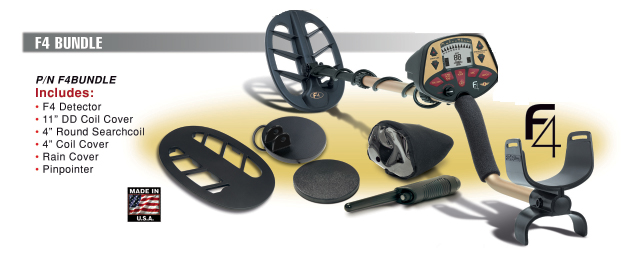
The F4 Bundle for $429 comes standard with an 11-inch elliptical search coil for maximum detection depth in mineralized soils. This special bundle also includes a DD coil cover, a 4 inch round searchcoil and coil cover, a rain cover, and a Fisher pinpointer.
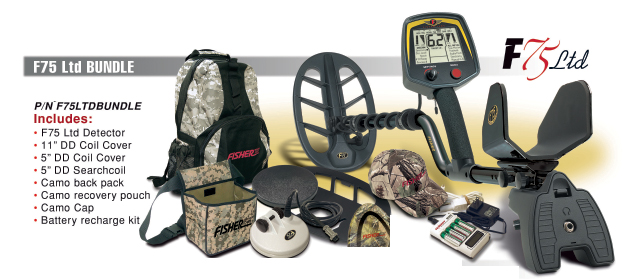
Although the Fisher F75LTD was improved in September 2014 with great NEW features to make it more versatile with greater depth, better target separation, and audio features that open up your iron-infested sites, it's now EVEN BETTER in a factory bundle for $1,129! In addition to the detector, you get an 11" DD Searchcoil with cover, a 5" DD Searchcoil with cover, a camo backpack, a camo recovery pouch, a camo cap, and battery recharge kit.
Fisher has recently introduced two professional grade metal detectors designed specifically for the Archaeological professional or any serious relic hunter: the Pro-Tech for $799 and the Pro-Arc for $1,399.

The Pro-Tech metal detector comes equipped with a carry case and everything you will need on the dig site— headphones, Fisher logo cap, rain covers, and field repair kit.
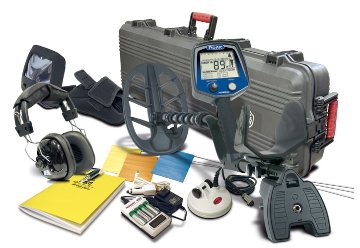
The Pro-Arc detector bundle includes headphones, rechargeable battery kit, pin flags with PVC stems (50 blue, 50 yellow, and 50 orange), Rite in the Rain paper, raincover, field repair kit, and hard carrying case.
Since 1931, Fisher has been the most trusted name in metal detection. The company's history began in the late 1920’s, when German immigrant Dr. Gerhard Fisher obtained the first patent ever issued on aircraft radio direction finders. He was working as a Research Engineer in Los Angeles, California at the time and his work attracted the interest of Dr. Albert Einstein. After a demonstration of Dr. Fisher’s equipment, Einstein enthusiastically and correctly predicted the world-wide use of radio direction finders in the air, on land and at sea.
Dr. Gerhard Fisher founded Fisher Research Laboratory in 1931 in a garage behind his home in Palo Alto, California. He and four employees began producing the "Metallascope," a rugged, easy-to-use metal detector. By today’s standards, it was perhaps an ungainly device: two large, flat wooden boxes containing simple copper coils, five vacuum tubes, and a few assorted components. It soon captivated the imagination of the country, and within a short time, the world. Today, it's a known fact that Fisher Finds More. All Fisher Metal Detectors are proudly made in the USA with a 5 year warranty. FREE SHIPPING to the Lower 48 states on all orders of $350 or more!
Friday, November 28 2014
 Move more material... get more gold is the best reason to upgrade your gold recovery efforts to a trommel, but now there's an even better incentive -- the 14 inch Pro Gold Trommel is 40% OFF through December 31, 2014 or until stock is depleted -- whichever comes first! That's right, this gold getting machine is now only $2,520 instead of $4,299! Move more material... get more gold is the best reason to upgrade your gold recovery efforts to a trommel, but now there's an even better incentive -- the 14 inch Pro Gold Trommel is 40% OFF through December 31, 2014 or until stock is depleted -- whichever comes first! That's right, this gold getting machine is now only $2,520 instead of $4,299!
How the Pro Gold Trommel works: Material is placed into the hopper, where the first spray zone washes the material before entering the rotating drum. The second spray zone, inside the rotating drum, washes the material as it tumbles. The third spray zone, outside the rotating drum, keeps the drum clean and helps wash the material. This unique design ensures the material is washed from multiple angles as the drum rotates, allowing a 5-gallon bucket of material to be processed in 2-3 minutes.
As the material is washed and tumbled, the smaller pieces and dirt fall through the drum’s heavy steel screen into the funnel assembly. From there they are directed into the top end of the sluice where the gold is separated. The larger material still in the rotating drum is tumbled and washed for the entire length of the drum and dropped out the end onto the rock chute.
The 14 inch trommel comes with a 4" Pro Inline Screen that captures the particles and vegetation in the water you are pumping to your machine and prevents them from plugging the holes in the spray bars of your equipment. You just connect a discharge hose from the pump to the inlet end of the Inline Screen. The arrows on the body indicate the water flow direction. Then connect the second discharge hose to the outlet end of the Inline Screen, using additional hose as required to connect to the equipment you are running.
The minimum amount of water needed for this 14 inch trommel is 145 gallons per minute, but the manufacturer recommends 190 so that you can adjust the flow down to your liking using the shut off valve on the trommel (water pump and hoses not included). A benefit of using a helix trommel is that the heavy material is brought up and out the top as opposed to possibly being washed away. This patented (D31, 900) Gold Trommel is heavy duty, easy to maneuver, user-friendly (detailed owner's manual included) and can process 25-30 five gallon buckets in 1.5 hours! Details include:
- Weight: 265 lbs.
- Dimensions: 72”- Ht. 44”- W. 32” at the wheels
- 2.5 hp gas HOR OHV, (electric available on request)
- Transmission: 1 speed belt to chain drive
- Rotating drum: 14”dia., L. 38”
- Sluice box: L. 48”- Ht. 4 ½”- W. 14”
Ready to take your gold recovery to the next level? If you want to run more material and ultimately find more gold, step it up a notch with this 14 inch gold trommel!
Monday, November 17 2014
Tesoro is the Spanish word for treasure, so it's no wonder this brand has been one of the industry's leading metal detector manufacturers for nearly 35 years. All 11 models are made in the USA and include a lifetime warranty. If you're looking for a brief comparison of the various models, below is a short description (in no particular order) of the strengths and price points of each Tesoro metal detector. Want to learn more about a particular model? Just click that link for greater detail and photos.
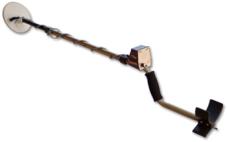 • If you're just getting started as a detectorist, the Compadre is the perfect introduction to the world of metal detecting and doesn't break the bank at only $165.50. This modest and effective detector has one knob to adjust the discrimination level, helping users to filt out unwanted targets. The Compadre represents the essence of metal detecting, where exploration and discovery combine to create a rich and rewarding hobby! • If you're just getting started as a detectorist, the Compadre is the perfect introduction to the world of metal detecting and doesn't break the bank at only $165.50. This modest and effective detector has one knob to adjust the discrimination level, helping users to filt out unwanted targets. The Compadre represents the essence of metal detecting, where exploration and discovery combine to create a rich and rewarding hobby!
• Tesoro's Silver uMax is known for its capable, uncomplicated 2-knob operation. With both a sensitivity and a discrimination adjustment, the Silver uMax provides more information about your targets and the conditions of your hunt. This machine also offers the option to change search coils, enhancing the versatility of this ultra-lightweight machine. Not bad for just $254.15!
• The Tesoro Outlaw Metal Detector ($437.75) represents the return of true no motion, all-metal treasure hunting. This machine has discrimination, sensitivity, threshold, and ground balance adjustments. The all-terrain Outlaw Coil Pack ($551.65) includes the detector and 3 coils: 5.75" concentric, 8" round concentric, and 12x10" widescan. The standard 8 inch coil provides great balance between depth and sensitivity and is an efficient pinpointer. The 5.75" coil utilizes tremendous sensitivity, making it an optimal tool for pinpointing targets. The 12x10 inch coil is less susceptible to ground effects, which means it is perfect for heavily mineralized sites or hunting larger targets.
• Intelligence meets simplicity in Tesoro's DeLeon -- an easy to use, turn-on-and-go metal detector for $509.15. This smart machine features digital processing, which allows you to get the most out of the its coil's signal. The visual identification system works in two ways: the detector samples the signal and provides a 5-bar graph that indicates the signal's average, and a 2-digit ID number shows the max signal strength.
 • The Cortes features visual and auto identification, notch filter and pre-set ground balance in discrimination mode and manual ground adjustment in all-metal mode. The VID (visual identification) system works in two ways: the detector samples the signal and provides a 9-segment bar graph of the entire signal and a 2-digit ID numbers shows the ID at the max signal strength. In addition to the expansive information provided by the VID, the Cortes boasts 9 different tones for superior audio identification and is priced at $721.65. Never guess a target again! • The Cortes features visual and auto identification, notch filter and pre-set ground balance in discrimination mode and manual ground adjustment in all-metal mode. The VID (visual identification) system works in two ways: the detector samples the signal and provides a 9-segment bar graph of the entire signal and a 2-digit ID numbers shows the ID at the max signal strength. In addition to the expansive information provided by the VID, the Cortes boasts 9 different tones for superior audio identification and is priced at $721.65. Never guess a target again!
• And you'll never miss a target with the Tesoro Cibola either since it is a powerful turn-on-and-go metal detector. It provides pre-set mineral rejection, which leaves you more time to hunt and less time manually readjusting to different types of soil. The Cibola is perfect for detecting with friends because of its frequency shift, which allows you to choose between 3 different frequencies and eliminate interference between metal detectors. This ultra light-weight treasure finder offers the ability to super-tune, causing it to overdrive small signals for better clarity. This multi-faceted machine does everything a more expensive detector can do, at a fraction of the weight and cost (only $361.25).
• Tesoro's Vaquero is an extremely effective machine, especially for an ultra- lightweight detector. It can do it all-- prospecting, coin shooting, and treasure hunting. The Vaquero has enough controls and features to be an excellent all-around machine that can be taken anywhere, yet the price is just $446.25. Manual ground balance allows users to control the Vaquero's response to the soil, even in highly mineralized locations. Similar to the Cibola, the Vaquero allows you to super-tune as well as shift frequencies when hunting with friends.
• The $594.15 Tejon metal detector features a dual discriminator that is activated by an effortless trigger switch, allowing for an instant target check. This detector also includes a tone adjustment option that is designed for treasure hunters who have lost the ability to hear certain audio frequncies. The Tejon pushes the coil's signal deeper while increasing sensitivity for smaller targets. This unit is full of features that amount to more informed choices, less time digging trash, and most importantly -- more time hunting.
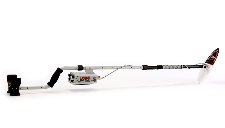 • Do you have gold fever? The Lobo Super TRAQ is an incredibly versatile, feature-rich machine that triumphs in small gold nugget prospecting. Spoil yourself with a detector that self-adjusts to any type of soil, even in highly mineralized locations. While the Lobo is designed to find gold, it also thrives in detecting coins, relics, and other treasures, too. A great value for only $679.15! • Do you have gold fever? The Lobo Super TRAQ is an incredibly versatile, feature-rich machine that triumphs in small gold nugget prospecting. Spoil yourself with a detector that self-adjusts to any type of soil, even in highly mineralized locations. While the Lobo is designed to find gold, it also thrives in detecting coins, relics, and other treasures, too. A great value for only $679.15!
• The Tiger Shark is hands down one of the best fresh water metal detectors on the market. This simple machine is made for the detectorist who wants to spend time finding treasure, not memorizing special controls and techniques. This machine's Salt Mode changes the ground balance range to handle salt instead of minerals. The Tiger Shark's coild and headphones are hardwired to the machine to protect it from leaks. Can be submerged up to 200 feet. Available with an 8 inch coil for $636.65 or a 10.5 inch coil for an extra $25.50.
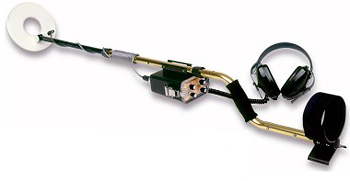 • The Tesoro Sand Shark is the perfect beach companion! The combination of moving salt water and mineralized soil can wreak havoc with your average detector. But since the Sand Shark utilizes Pulse Induction technology, it eliminates this issue and allows you the ability to hunt in areas that frustrate other detectorists. This unit provides control over the pulse width to balance batterly life and depth. The Sand Shark also includes a tone adjustment, allowing the user to choose either a variable pitch or a single tone. This machine's headphones and coils are hardwired to the detector to protect it against leaks. Dive up to 200 feet. Available with an 8 inch searchcoil for $577.15 or $602.65 with a larger 10.5 inch search coil. • The Tesoro Sand Shark is the perfect beach companion! The combination of moving salt water and mineralized soil can wreak havoc with your average detector. But since the Sand Shark utilizes Pulse Induction technology, it eliminates this issue and allows you the ability to hunt in areas that frustrate other detectorists. This unit provides control over the pulse width to balance batterly life and depth. The Sand Shark also includes a tone adjustment, allowing the user to choose either a variable pitch or a single tone. This machine's headphones and coils are hardwired to the detector to protect it against leaks. Dive up to 200 feet. Available with an 8 inch searchcoil for $577.15 or $602.65 with a larger 10.5 inch search coil.
No matter which Tesoro metal detector you choose, the words of founder Jack Gifford hold true: "As the Spaniards were yesterday's undisputed masters of treasure hunting, we at Tesoro will always endeavor to meet our goal of making Tesoro Metal Detectors today's undisputed masters of treasure hunting." FREE SHIPPING on any detector priced $350 or more!
|







 were too far away from Barkerville! Today, more than 100 historic structures are still standing on the spots that they were built; many are active businesses. For the price of admission, this period frontier town offers daily activities and special events during the summer— guided town tours, blacksmithing demonstrations, story-telling by costumed interpreters, living history presentations— as well as shopping, dining, gold panning, and much more.
were too far away from Barkerville! Today, more than 100 historic structures are still standing on the spots that they were built; many are active businesses. For the price of admission, this period frontier town offers daily activities and special events during the summer— guided town tours, blacksmithing demonstrations, story-telling by costumed interpreters, living history presentations— as well as shopping, dining, gold panning, and much more. 

 If you've not yet attended a GPAA (Gold Prospectors Association of America) Gold & Treasure Show, the coming months provide an opportunity to rub elbows with some of the best prospectors and manufacturers in the business! Browse the show floor to find the latest and greatest gold mining and metal detecting equipment, see product demos, attend free seminars, ask questions of the pros, and enter to win door prizes. Weekend shows run 10 am - 4 pm. Presale admission is $5 by registering online or $10 at the door.
If you've not yet attended a GPAA (Gold Prospectors Association of America) Gold & Treasure Show, the coming months provide an opportunity to rub elbows with some of the best prospectors and manufacturers in the business! Browse the show floor to find the latest and greatest gold mining and metal detecting equipment, see product demos, attend free seminars, ask questions of the pros, and enter to win door prizes. Weekend shows run 10 am - 4 pm. Presale admission is $5 by registering online or $10 at the door.
 my wrist, which gave it a perfect fit and feel, and allowed me to work all of the control buttons easily with my thumb. I pushed the unit out in front of me a bit and turned on the power switch, which is located on the back of the unit. The Garrett ATX Deepseeker Metal Detector goes through its startup and self-diagnostic test. Every light on the control pad comes on and unit emits several different sounds before settling into a comfortable, but high, threshold. This is not a turn-on-and-go detector. Either read the entire owners manual before you go out hunting, or at least read the first two pages of the manual— page 1 is the Quick Start Guide and an explanation of how to access the functions of the ATX quickly, and page 2 shows you where to find more information concerning those functions.
my wrist, which gave it a perfect fit and feel, and allowed me to work all of the control buttons easily with my thumb. I pushed the unit out in front of me a bit and turned on the power switch, which is located on the back of the unit. The Garrett ATX Deepseeker Metal Detector goes through its startup and self-diagnostic test. Every light on the control pad comes on and unit emits several different sounds before settling into a comfortable, but high, threshold. This is not a turn-on-and-go detector. Either read the entire owners manual before you go out hunting, or at least read the first two pages of the manual— page 1 is the Quick Start Guide and an explanation of how to access the functions of the ATX quickly, and page 2 shows you where to find more information concerning those functions. There are 5 major functions that are completely user-adjustable: Mode, Sensitivity, Threshold, Volume, and Ground Balance. Are functions are easy to adjust with a basic understanding of the ATX and more tunable as you become more proficient. Secondary functions include iron check, tracking, discrimmination and frequency shifting, to name only a few.
There are 5 major functions that are completely user-adjustable: Mode, Sensitivity, Threshold, Volume, and Ground Balance. Are functions are easy to adjust with a basic understanding of the ATX and more tunable as you become more proficient. Secondary functions include iron check, tracking, discrimmination and frequency shifting, to name only a few.


 achines worth every penny all on their own, but the value gets even better when the manufacturer puts together special holiday bundles that include extra coils and other useful items and
achines worth every penny all on their own, but the value gets even better when the manufacturer puts together special holiday bundles that include extra coils and other useful items and 



 Move more material... get more gold is the best reason to upgrade your gold recovery efforts to a trommel, but now there's an even better incentive -- the
Move more material... get more gold is the best reason to upgrade your gold recovery efforts to a trommel, but now there's an even better incentive -- the 

 • Do you have gold fever? The Lobo Super TRAQ is an incredibly versatile, feature-rich machine that triumphs in small gold nugget prospecting. Spoil yourself with a detector that self-adjusts to any type of soil, even in highly mineralized locations. While the Lobo is designed to find gold, it also thrives in detecting coins, relics, and other treasures, too. A great value for only $679.15!
• Do you have gold fever? The Lobo Super TRAQ is an incredibly versatile, feature-rich machine that triumphs in small gold nugget prospecting. Spoil yourself with a detector that self-adjusts to any type of soil, even in highly mineralized locations. While the Lobo is designed to find gold, it also thrives in detecting coins, relics, and other treasures, too. A great value for only $679.15!